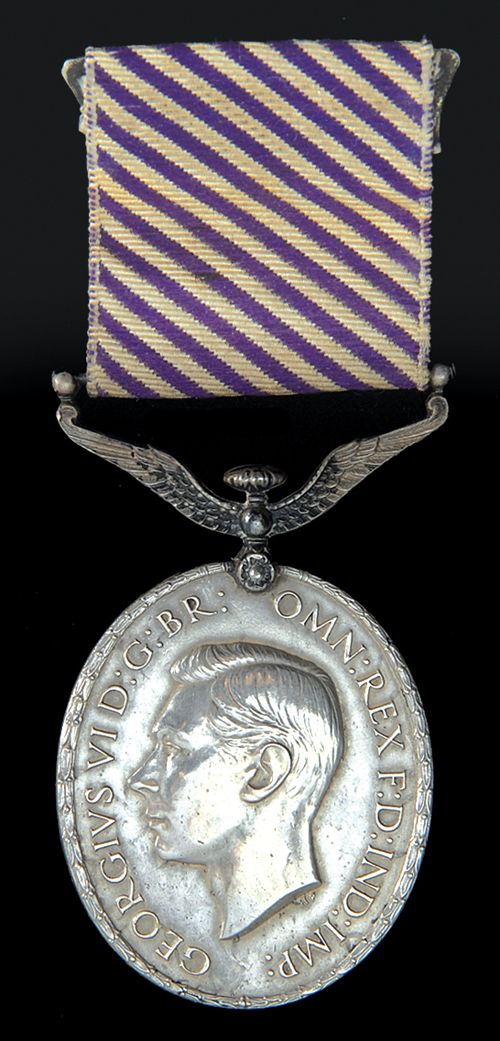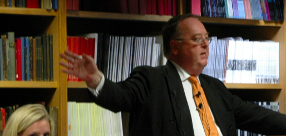
Auction: 8023 - Orders, Decorations, Medals & Militaria
Lot: 58
A Second War ´Immediate´ Evaders D.F.M. to Halifax Bomb Aimer Sergeant, Later Pilot Officer M.A.T. Davies, Royal Air Force Volunteer Reserve, Who Having Flown 21 Operational Sorties with 76 Squadron, Was Shot Down en route to Frankfurt By an Enemy Night Fighter; He Was Injured Bailing Out and When He Regained Consciousness Found Himself Lying in a Wood in Occupied France; He Successfully Evaded Capture with One of His Crew Members, and with the Help of the French Resistance Made it Back to England, Via Gibraltar, Two Months Later Distinguished Flying Medal, G.V.I.R. (1072959. Sgt. M.A.T. Davies. R.A.F.), very fine Estimate £ 1,600-2,000 D.F.M. London Gazette 6.7.1943 Davies, Maurice Alfred Torwerth, 1072959 Sergeant 76 Sqn, the Recommendation, dated 21.6.1943, states, ´´Sergeant Davies was the Bomb Aimer of the crew of a Halifax aircraft of No. 76 Squadron which was detailed to bomb Frankfurt on the 10th April, 1943. On the outward journey the aircraft was attacked and set on fire by an enemy fighter. The Captain gave the order to bale out. Sergeant Davies was injured on leaving the aircraft and when he regained consciousness found himself lying in a wood. His neck was badly bruised and his face cut. Sergeant Davies then proceeded W.S.W. and evading capture eventually arrived back in this country. For the courage and determination shown by this N.C.O. in making his escape I recommend the immediate award of the D.F.M.´´ 1072959 Pilot Officer Maurice Alfred Torweth Davies, D.F.M., born 1911, and prior to the outbreak of the Second World War was a Schoolmaster in Abergele, North Wales; joined the Royal Air Force Volunteer Reserve. 1.10.1940; trained with No. 24 O.T.U. (Honeybourne); he served as a Sergeant, Bomb Aimer, with 76 Squadron (Halifaxes), Linton-on-Ouse, Yorkshire and flew in 21 operational sorties with the Squadron, including to Frankfurt, 10/11.4.1943, in Halifax II JB871 MP-V, piloted by Flight Lieutenant A.H. Hull, ´´T/O 2311 Linton-on-Ouse. Outbound at between 16,000 and 17,000 feet, shot down by a night fighter and crashed 0100 near Hirson (Aisne) 15km NE of Vervins, France. F/L Hull was found in the wreckage of his cockpit, while the others who died were found nearby. Together, they are buried in Hirson Communal Cemetery.´´ (Royal Air Force Bomber Command Losses of the Second World War, refers); Davies M.I.9. Debrief offers more insight, ´´Some time after landing we were told by our French helpers that F/Lt. Hull, captain and pilot, was killed in the aircraft, and was buried in the cemetery in Hirson (Nord) on 16 Apr 43. Sgts. Paignter (navigator), Matthews (wireless operator), and Bozier (mid upper gunner), who were apparently killed on landing, were buried in the same cemetery on 14 Apr. We were told that 6,000 people attended the funeral on 14 Apr, and that all the graves were heaped with flowers. We were also told that a man who might have been F/O David (rear gunner) had bought a railway ticket to Soissons. I believe that David can speak fair French. I baled out from about 15000 feet. In descending I was knocked unconscious by what I now believe to have been a piece of the aircraft. When I came to, I was lying on the ground in a wood, and my parachute and harness were stuck in a tree some little distance away. My neck was badly bruised and face cut. I tried to pull down my parachute but it was too firmly fixed. I could see the aircraft burning some little distance off. With the aid of a compass I walked W.S.W. away from it, hoping that by this means I should be walking towards France. I was still wearing my mae west and Irvine jacket. During the night I filled my water bottle near a farm. At daybreak on 11 Apr I hid myself in a wood. While here I cut off my rank badges, pulled my trousers over my boots and buried my mae west and jacket in some undergrowth. I then opened my escape box and purse and removed the identification marks from their contents and stowed them about my person. At 0700hrs I noticed an old man catching moles. I also saw an old match box lying on the ground with French writing on it. I therefore assumed I must be in France, and I approached the mole-catcher and declared myself to him. He said he could not help me, but pointed to a farm nearby. I went back into the wood... Eventually I walked to the back door of the farm he had indicated, and asked for some food. The farmer welcomed me into the house, but his wife seemed very scared. They gave me some food and after telling me there were some Germans about, more or less indicated that I should leave them. I therefore went back to the wood, which I think must have been near Les Valees, about 4 miles S.E. of Hirson...... Eventually I came to the Hirson-Aubenton main road. There were some people on bicycles on the road. A woman of about 40... turned and came back, dismounted, and said to me in French, "You are an English aviator, aren´´t you?" She then took me to a farm belonging to a Belgian, and after assuring him that she would arrange for me to be taken away later, left me. The farmer gave me some food and hid me in a copse near his house. About 1700hrs he and another man were about to hide me under some hay in a pony trap and take me to a neighbouring village, when a boy arrived on a bicycle. This boy asked me the names of the other members of my crew and the type of my aircraft, and inspected my identity discs. I showed him also my stripes and badges which I was carrying in my pockets. He said I was to stay at the farm a little longer, and went away. At 2200hrs the boy returned and took me a little way down a road, where I was picked up by a car and taken to a neighbouring village, where I met Sgt. Strange.... From this point our subsequent journey was arranged for us.´´ Sergeant M.B. Strange was the Flight Engineer from Davies´´ crew. Having been reunited, Davies and Strange made their way to Gibraltar assisted by the French Resistance. They left Gibraltar on the 6th June 1943, arriving in Hendon the following day.
Sold for
£2,500




